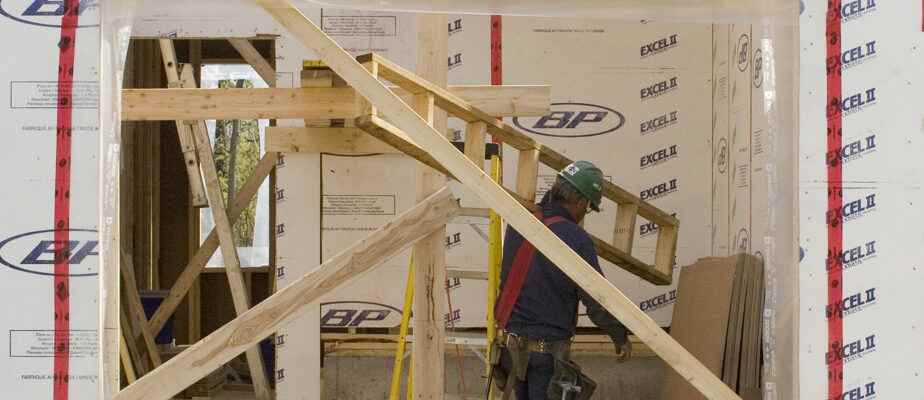Updated at 9:35 a.m.
This is the story of a century-old property located on rue Saint-Urbain, in the Plateau Mont-Royal, which had kept all its moldings, rosettes, picture rails, not to mention a fireplace mantel with columns and a sideboard. recessed. Sold for $395,000 in February 2022, it is back on the market, completely renovated, at $790,000. However, most of the period decorative elements have disappeared to make way for smooth white walls.
Former journalist Philippe Orfali recognized the property on Centris, then found the announcement of the first sale. On Twitter, he posted four photos showing two rooms, the master bedroom and the living room, before and after the renovations. The reactions were not long in coming.

IMAGE FROM TWITTER
Tweet from former journalist Philippe Orfali
” Another flip cheap. Such a waste ! wrote Marie Plourde, City Councilor for Mile End District.
“It’s a big loss of heritage, that’s clear,” said Stéphane Lessard, president of JG Lessard et Fils, a general contractor who carries out restoration work on old buildings in Montreal, in an interview.
-

PHOTO PROVIDED BY BROKER GONZALO NÚÑEZ
BEFORE WORK
The living room, with its built-in sideboard -

PHOTO FROM CENTRIS
AFTER THE WORK
The living room. In addition to the sideboard, the picture rails on the walls have disappeared. -

PHOTO PROVIDED BY BROKER GONZALO NÚÑEZ
BEFORE WORK
The master bedroom, with the pillared fireplace mantle -

PHOTO FROM CENTRIS
AFTER THE WORK
The master bedroom. The hearth is no longer there. The ceiling has also been lowered.
1/4
As for me, it’s a flip missed. It can be repaired, the walls and moldings, everything can be repaired, but here, everything has been replaced. Then, shrink from above [en abaissant le plafond]it is a disaster !
Stéphane Lessard, president of JG Lessard et Fils
Whether they find them to their liking or not, too many people are unaware of the value of the original decorative elements in old constructions, further believes Mr. Lessard. “The hearth that was removed today is worth a fortune,” he said. No one will ever be able to fix that. »
The current co-owners preferred not to comment on the case.
Expensive Destruction
Of course, a custom-made solid wood molding costs a lot more than its MDF counterpart sold at a home improvement store. “But sometimes it’s cheaper to work with craftsmen to restore original elements than to tear everything out,” believes Taïka Baillargeon, assistant director of policies at Héritage Montréal.
These craftsmen are sometimes difficult to find, recognizes Mme Baillargeon, but she has noticed a renewed interest in traditional skills, with training at the Cégep du Vieux Montréal, in particular.

PHOTO MARCO CAMPANOZZI, PRESS ARCHIVES
Taïka Baillargeon, Deputy Policy Director at Héritage Montréal
“Of course we can’t keep everything,” adds the one who says she is saddened by the unfortunate renovations. “But if you lose everything – and there are few original interiors left – you lose a lot of knowledge, for example about how people lived in houses when they were built. »
Informing owners of the true value of their acquisitions would certainly help preserve the interior heritage, believes Taïka Baillargeon, assistant director of policies at Héritage Montréal.
Encourage, not compel
“We can’t blame people who haven’t been made aware,” adds Marie Plourde on the phone. The example of rue Saint-Urbain is the culmination of decades of disinterest in heritage. »
The elected also criticizes the culture of flip and its promises of easy money, promoted by the multitude of TV shows that encourage serial nondescript renovations.
The Plateau-Mont-Royal borough is one of the strictest when it comes to protecting outdoor heritage. It can force some owners to restore missing elements, such as cornices. Should it also do this for the interior?

PHOTO MARCO CAMPANOZZI, PRESS ARCHIVES
Marie Plourde, City Councilor for Mile End District
No question of adopting such a binding regulation, answers Marie Plourde. “It’s not by force of the knife that we’re going to impose this,” she said.
There are other ways to act. A municipality can thus grant heritage status to a property in order to preserve its interior as well. But… “it would be a huge undertaking to take stock of everything that needs to be protected”, observes Marie Plourde.
The elected prefers that the borough accompanies the owners, by helping them for example to get their hands on the subsidies offered by the city-center, which come from an envelope of Quebec.
Marie Plourde would also like to strongly encourage the recovery of heritage elements and building materials, which too often end up in the garbage following construction work. “We are still looking at how it could be done, in the borough, but it would be a first milestone. »
Better renovating heritage interiors would reduce waste, also believes the spokesperson for Heritage Montreal. “We can no longer demolish and build as we have done for years, it is far too polluting,” believes Taïka Baillargeon.

